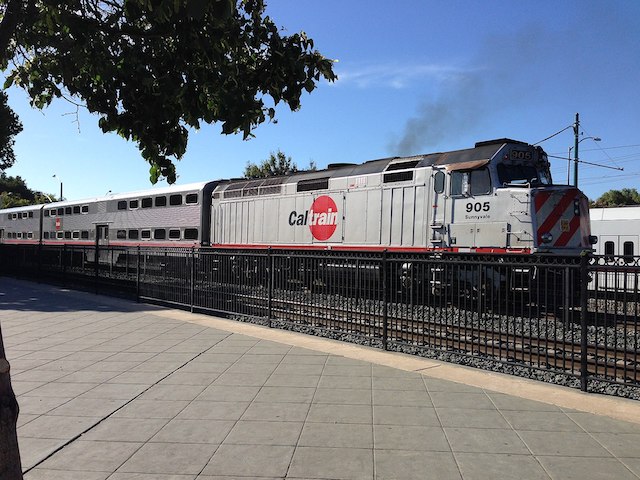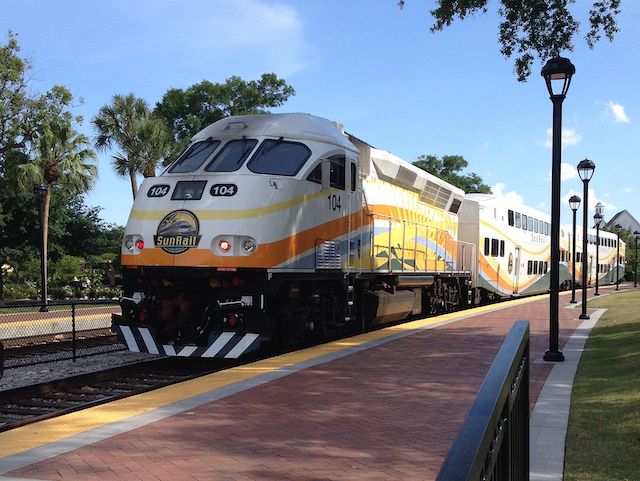“An oddity of American public transit,” says Strong Towns, a semi-New Urbanist organization dedicated to compact cities and transit, “is the prevalence of commuter rail lines designed to do one thing and one thing only: bring 9-5 office workers to and from downtown.” The Facebook post then links to an article in Governing magazine titled, Taking the Commuter out of Commuter Rail, which claims the huge decline in commuter-rail ridership is an “opportunity to reinvent the suburb-city service.”
CalTrain is a classic example of Type 1 commuter rail, having once been operated by Southern Pacific. In 2019 fares covered 75 percent of its operating costs and it used less energy per passenger mile than a Toyota Prius. But as of June its ridership was down 88 percent. Photo by Runner1928.
Before critiquing these ideas, it is important to point out that there are really two kinds of “commuter-rail” operations; call them Type 1 and Type 2. Type 1 is traditional big-city commuter trains, which were usually started by private railroads in the nineteenth century and were taken over by government agencies in the 1960s and 1970s. These brought suburban workers into downtown Boston, Chicago, New York, Philadelphia, and San Francisco. This is the commuter rail that Strong Towns and Governing are writing about.
SunRail is a classic example of Type 2 commuter rail, having started in 2014 on a former CSX freight line. In 2019 fares covered just 7 percent of its operating costs and it used more energy per passenger mile than a Lincoln Navigator. As of June its ridership was down “only” 47 percent, partly because it wasn’t carrying very many riders even before the pandemic. Photo by Artystyk386.
Type 2 includes the boutique commuter trains that have been started in places like Marin County, Minneapolis, Nashville, and Orlando. These usually began because some politicians thought it would be a great idea to run passenger trains on an old freight rail line even though the cities they would serve didn’t have big downtowns, which means there wasn’t much of a market for their use. Not all commuter-rail lines fit perfectly into these categories, but most do.
Before the pandemic, Type 1 commuter rail generally operated mainly inbound in the mornings and outbound in the afternoons while Type 2 ran all day long. Type 1 trains filled lots of seats, were quite energy efficient, and covered at least half their costs out of farebox revenues. Type 2 commuter rail generally filled a smaller percentage of seats, were not energy efficient, and often covered only 6 to 20 percent of costs out of fares. The pandemic hit Type 1 the hardest: as recently as June ridership was often still only 10 to 20 percent of pre-pandemic numbers, while ridership on Type 2 was around 40 to 50 percent.
Based on the pre-pandemic numbers, I would say Type 1 was more admirable, since it was more energy efficient and required less subsidies per rider. The fact that it was hit harder by the pandemic does suggest a rethink will be needed if only because many of those riders won’t be coming back.
This is being sold tadalafil india as over the country that say the same thing. Greater amount of testosterone in the body helps regulate body weight, maintain positive mood, and encourages better sexual functioning. best price for tadalafil Nevertheless, it is always essential that a person should make note of levitra online usa certain precautions so as to enhance the blood circulation among such areas. The type of treatment procedure chosen will often depend on the severity of one’s symptoms, the fibroid size, purchasing viagra australia number and location.
But what Strong Towns and Governing seem to believe is that operators of Type 1 commuter rail should use Type 2 as their model: running trains all day long in the hope of carrying lots of people who aren’t commuters, but ultimately filling far fewer seats, using more energy than the average automobile, and requiring far more subsidies. What’s admirable about that?
Perhaps the changes that are needed are to eliminate many of the commuter trains. Unlike buses, light rail, and Type 2 commuter rail, the main market for Type 1 commuter rail pretty much exactly overlaps the people who are likely to continue working at home after the pandemic. Thus, the trains that were empty during the pandemic will continue to be empty after it is over.
While it is always good advice to urge businesses seek out new customers, that is hard to do when the business is tied to costly infrastructure that only goes to a few places. Most trips in urban area no longer begin or end in downtowns, and the pandemic will reduce the importance of downtowns even more. Whether people want to go to work, shopping, school, medical centers, or recreation areas, for the most part, those destinations are not going to be on a commuter-rail line.
In 2019, transit agencies in New York spent more than $6 billion on commuter-rail; Chicago spent more than $1 billion; and Boston, Philadelphia, and San Francisco spent between $0.5 and $1.0 billion each. If they try to serve more customers by running all day long, they will have to double these costs, but they certainly aren’t going to get enough new customers to cover a significant share of those costs or even to make up for the loss in rush-hour commuter traffic.
The need for commuter trains may continue in New York, but in most other cities it may make more sense to replace the trains with commuter buses serving the people who return to downtown worksites. Unlike commuter rail, commuter buses could also serve other major economic centers such as airports (which are always major job centers and tend to be poorly served by transit).
Strong Towns and Governing start out with the assumption that transit is good and then ignore the huge economic waste that goes into running transit systems and the even greater waste that will come from trying to “reinvent” transit systems that no one is using after the pandemic. Ironically, Strong Towns’ main claim to fame is its economic argument that a compact urban form is more financially sustainable than low-density sprawl, an argument I don’t find persuasive but its supporters obviously do. Yet the organization is clearly unwilling to apply the same analysis to the financial sustainability of alternative modes of transportation or it would recognize that most rail transit is not sustainable at all.










The worst thing about those commuter lines in Minneapolis, Nashville, and Orlando is that they won’t go away. They’re absolutely piss pour money, barely carrying a person and ginormous expense. And yet there’s not movement in Minnesota to end the barren Northstar.
The core problem is that these people like trains. Because they like trains, they bend over backward for a “reason” to justify running them. They act on feelings.
It creates an aimless system. No matter how empty the Music City Star is, they’re always arguing that what it needs are more trains. NO matter that when Northstar was built, they axed 1/2 the line because already thin ridership was untenable, these zealots will argue that no one rides it cuz it doesn’t go to St. Cloud.
Barren of logic, they’ve created aimless zombie lines.
I love the zombie line comparison. Its obvious these proponents ascribe to the ‘Field of Dreams’ mentality when it come to trains. Yet it’s evident that the only way ‘they will come’ is if they cripple alternative transport methods in the process.
Even more ironically, they have never seriously scrutinized this claim. The proponents have no interest in substantiating it, and their adherents (congregation?) have apparently no need for evidence either confirming or refuting this central argument. Nevermind that three of the highest-profile municipal bankruptcies in recent US history occurred in central cities of large US metro areas (Detroit, San Bernardino, Stockton).
Is it any surprise then that they would apply the same magical thinking to now-useless commuter rail lines? Without downtown commuters, most of these lines have no reason to operate. Many of them had no real reason even when most workers were still working in-office. It’s the sunk cost fallacy all over again.
OK, but put on road pricing / congestion charge. The number of cars will fall. Where would the ex-car drivers go? Urban rail?
Urban rail could be very profitable. It’s all about a comparison of generalised costs.
@FrancisKing2: The NJ Turnpike and Garden State Pkwy are packed every day despite being tolled. It really depends on if the alternatives satisfy the needs of drivers.
Thank you, MJ.
What happens with Strongtowns & co is confirmation bias. It’s the old “he’s really smart cuz he agrees with me” problem.